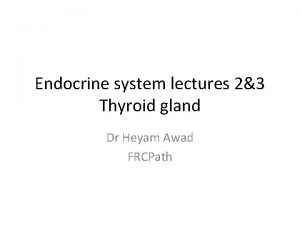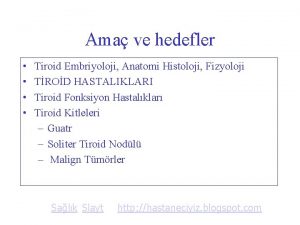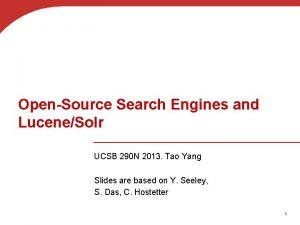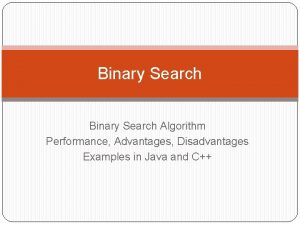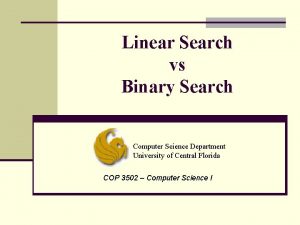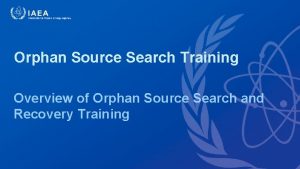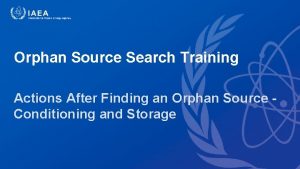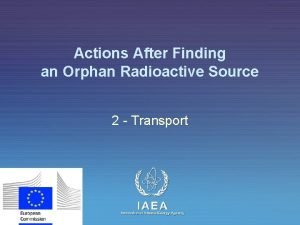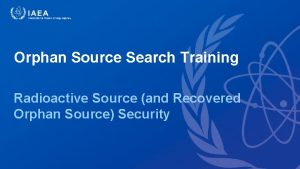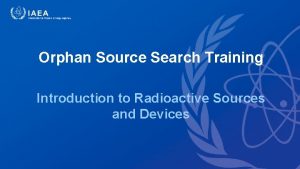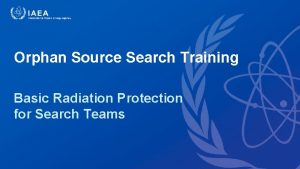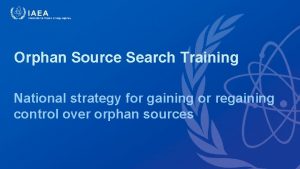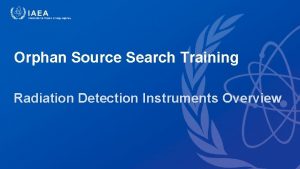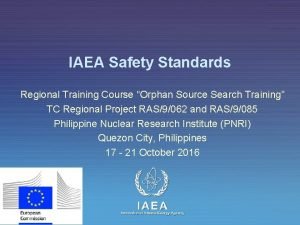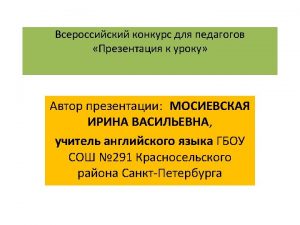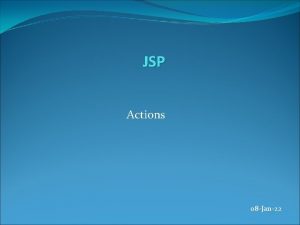Orphan Source Search Training Actions After Finding an
























- Slides: 24

Orphan Source Search Training Actions After Finding an Orphan Radioactive Source – Source Recovery

Actions After Finding an Orphan Radioactive Source - Introduction • There are four distinct steps that must be implemented after finding an orphan radioactive source. These steps are: – – Orphan source identification and characterization Packaging and transport Conditioning Safe and secure storage • This presentation addresses the first step, identification and characterization Actions After Finding an Orphan Radioactive Source – Source Recovery 2

Overview • • Orphan source identification and characterization Initial actions – dose assessment/reconstruction Source/device information Source characterization Gamma ray constants and shielding factors Radiography example Sample source transfer form Actions After Finding an Orphan Radioactive Source – Source Recovery 3

Initial Actions – Radiological Safety • Control access in the area around the source/device – e. g. rope off at an acceptably low dose rate (0. 1 m. Sv h-1), as appropriate. • Observe the source from a distance (e. g. using binoculars, as appropriate) • Approach the source slowly using a dose-rate meter, as appropriate. • Ensure dose rates are acceptable for subsequent actions in all directions around the device/source - in case there is a beam Actions After Finding an Orphan Radioactive Source – Source Recovery 4

Initial Actions – Radiological Safety <1 Sv/h 520 Sv/h Actions After Finding an Orphan Radioactive Source – Source Recovery 5

Initial Actions – Radiological Safety Dose assessment (reconstruction) Actions After Finding an Orphan Radioactive Source – Source Recovery 6

Initial Actions – Radiological Safety Dose assessment (reconstruction) Actions After Finding an Orphan Radioactive Source – Source Recovery 7

Initial Actions – Radiological Safety • Measure the dose rate near the device/source (at contact and at 1 meter), if safe. • Swipe the device/source for leakage or contamination using long-handled tongs. Monitor swipe elsewhere, away from the source • Check for damage (if safe): Damaged portable gauge – Shield intact? – shutter open or closed? Actions After Finding an Orphan Radioactive Source – Source Recovery 8

Device/Source Information Requirements Gather as much information as you can, in the field, about – Radionuclide – Activity – Dose rates – Contamination levels Device data plates, Markings on a shipping package, Shipping paper work. All are helpful. Actions After Finding an Orphan Radioactive Source – Source Recovery 9

Initial Actions – Source Identification • • Record data from any label present, if legible Take pictures of label plate and source Actions After Finding an Orphan Radioactive Source – Source Recovery 10

Initial Actions – Source Identification • • Identify radionuclide using a hand-held spectrometer Record the results and save the spectrum Actions After Finding an Orphan Radioactive Source – Source Recovery 11

Initial Actions – Source Identification • Attempt to specifically identify the source/device or failing this, to identify the type of source using: – The observed and measured data – Information provided in the IAEA Nuclear Security Series no. 5 – Information from the administrative search – Available data regarding missing sources – Other references such as the IAEA International Catalogue of Sealed Radioactive Sources (ICSRS) Actions After Finding an Orphan Radioactive Source – Source Recovery 12

Source Characterization • Determine the source activity from: – data on the label and a decay correction, or if no information available, – dose rate at a known, safe distance and knowledge of the isotope identified (for beta/gamma sources) Actions After Finding an Orphan Radioactive Source – Source Recovery 13

Source Characterization Γ. A D= r 2 A= Actions After Finding an Orphan Radioactive Source – Source Recovery D. r 2 Γ 14

Source Characterization • • Use inverse square law and specific gamma ray constants Account for any shielding present • Dose rate changes with distance • D 2 (r 22) = D 1 (r 12) Inverse Square Law Use of Measured Data • • • D 1 = Measured dose rate at distance r 1 D 2 = Dose rate at distance of interest r 2 D 3 = Dose rate at distance of interest r 3 15

Some Specific Gamma Ray Constants Nuclide (mrem/hr)/m. Ci @ 1 m (μSv/hr)/MBq @ 1 m 60 Co 1. 29 0. 306 137 Cs 0. 32 0. 076 192 Ir 0. 48 0. 113 226 Ra* 0. 73 0. 173 * = in equilibrium with daughters Actions After Finding an Orphan Radioactive Source – Source Recovery 16

Some Shielding Factors Nuclide 60 Co 137 Cs 192 Ir 226 Ra HVL or TVL Concrete (2. 5 g/cm 3) Lead (11. 3 g/cm 3) HVL 6. 2 cm 1. 2 cm TVL 21. 8 cm 4. 5 cm HVL 4. 8 cm 0. 7 cm TVL 17. 5 cm 2. 2 cm HVL 4. 3 cm 0. 6 cm TVL 15. 2 cm 1. 6 cm HVL 6. 9 cm 1. 7 cm TVL 24. 0 cm 4. 5 cm Numbers taken from IAEA Safety Series No. 47 Actions After Finding an Orphan Radioactive Source – Source Recovery 17

Example - Radiography • A source identified as 60 Co for industrial radiography, in its shielded position is measured to have a dose rate of 50 μSv/h at one meter • The camera data plate indicates an activity of 100 Ci five yrs ago. • The half life of Co-60 is 5. 26 yr. Therefore one half of the activity has decayed and the camera contains about 50 Ci of Co-60. Actions After Finding an Orphan Radioactive Source – Source Recovery 18

Example (cont. ) • A source identified as 60 Co for industrial radiography, without any data, in its shielded position, is measured to have a dose rate of 50 μSv/h at one meter • The camera lead shield seems to be about 20 cm thick. • 20 cm is about 4 tenth value layers (TVL), so the dose rate from an unshielded source would be about 10, 000 times greater i. e. 500 m. Sv/h at one meter Actions After Finding an Orphan Radioactive Source – Source Recovery 19

Example (cont. ) D x. r 2 A= Γ • Hence the activity of the source is about: 500 (m. Sv/h)/3. 06 x 10 -4 MBq/(m. Sv/h) 1. 63 x 106 MBq or 1. 63 TBq • This is consistent with a 60 Co industrial radiography source as given in App I, Table 2 of RS-G-1. 9 (Categorization of Radioactive Sources) • It would be a Category 2 source Actions After Finding an Orphan Radioactive Source – Source Recovery 20

Next Actions • Once the initial actions have been completed – the device/source will usually need to be packaged for transport – paperwork, labels, and marking must be prepared – transport it to a safe and secure location – condition the source/device, as needed – store it in a safe and secure manner awaiting a decision on final disposition. Actions After Finding an Orphan Radioactive Source – Source Recovery 21

Example of a source transfer form Actions After Finding an Orphan Radioactive Source – Source Recovery 22

Summary • Why is it important that the radiological environment of the orphan source be fully characterized? • What information should be used to characterize the source? • Why is the source/device transfer form important? Actions After Finding an Orphan Radioactive Source – Source Recovery 23

Thank you!
 After me after me after me
After me after me after me If any man wants to come after me
If any man wants to come after me The orphan boy and the elk dog theme
The orphan boy and the elk dog theme Orphan graphic design
Orphan graphic design Orphan annie eye nuclei
Orphan annie eye nuclei Orphan train museum kansas
Orphan train museum kansas Museum timelinefy
Museum timelinefy Warm up movie
Warm up movie There is a languid emerald sea meaning
There is a languid emerald sea meaning Open orphan investor relations
Open orphan investor relations Orphan gpcr
Orphan gpcr Orphan annie hücreleri
Orphan annie hücreleri Open source search engines
Open source search engines The blind search algorithms are.
The blind search algorithms are. Federated search vs discovery
Federated search vs discovery èinterest
èinterest Federated search vs distributed search
Federated search vs distributed search What is informed search and uninformed search
What is informed search and uninformed search Images.search.yahoo.com
Images.search.yahoo.com Best first search in ai
Best first search in ai Blind search adalah
Blind search adalah Video.search.yahoo.com search video
Video.search.yahoo.com search video Video.search.yahoo.com search video
Video.search.yahoo.com search video Disadvantages of algorithm
Disadvantages of algorithm Search by image
Search by image




